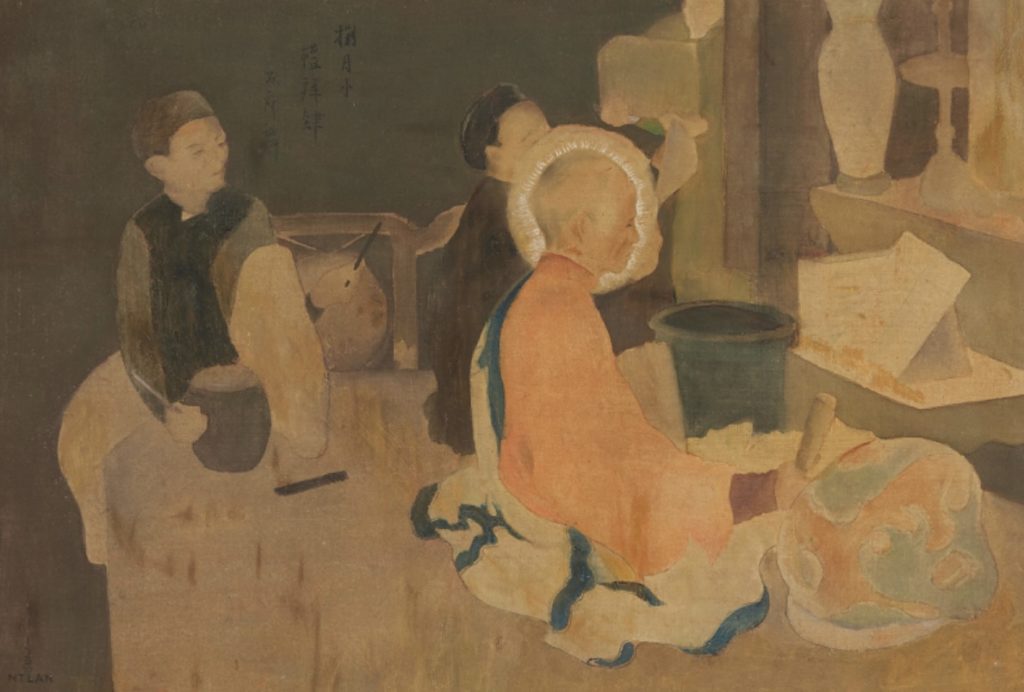Nguyen Tuong Lan « In The Lotuses », 1933, or the graceful emancipation of the vietnamese woman
Nguyen Tuong Lan had just graduated from the Hanoi School of Fine Arts in the 4th class (1928-33) when he painted this sublime large-scale (46,5 X 78 cm) gouache and ink on silk, where freshness, imagination and meaning exult.

“In the lotuses”, is the title inscribed on the back of the painting chosen by the artist. He could have named it “the lotuses”, a semantic detail that gives away part of the key to the work.
Among the lotuses that dominate the picture is a young woman, characterized by the inky black of her hair and the brown of the bamboo boat (or pontoon) on which she sits in a delicate balance. The painter off-centers her towards the top left of the composition.
In profile, anonymized, in a gesture of great delicacy with both hands, she grasps a lotus flower. A lotus among others, in bloom or bud, accumulated on the water where its leaves compete with the water lilies. Like a plant swell.
The young woman wears the modern ao dai, conceptualized by Nguyen Cat Tuong (1912-1946), the artist’s fellow student at the Hanoi School of Fine Arts. The garment’s success amongst young women, who asserted their modernism in the face of the old Confucian world that oppressed them, would never be denied.
The vivid, precise brushstrokes, the daring composition with its double imbalance – of the scene and the young woman – the use of ink more in dabs than in compact form, and the subtle tonalities make up a work that is remarkable in its beauty, but also astounding in its meaning.
Ngyen Tuong Lan is sensitive to the sacred. This is demonstrated, if necessary, by her “A la Pagode” belonging to the Tholance-Lorenzi collection, (Christie’s Hong Kong November 23, 2014, number 335).

Of course, culturally, the lotus still represents the flowers that fell from a cloudless sky at Buddha’s birth, the lotus stem held by a bodhisattva to announce his birth, the plant that touches the earth through its roots, water through its stem, air through its flower. And, unsinkable, it blooms under the action of the sun’s heat, as its leaves do not float on the water, like those of water lilies, but rise above the surface. It is also the plant whose seed passes from the air into the water, germinates in the mud, grows, then flowers again to become a seed. A symbol of reincarnation, nirvana and the Wheel of the Law. And the list goes on.
Nguyen Tuong Lan knows all this. Feels it, is imbued with it, as he is with Confucianism.
But the painter is also a militant, a nationalist modernist, at the heart of the creation of the Tự Lực văn đoàn, this Vietnamese movement that was born concretely in this year 1933 and advocates the modernization of Vietnamese society, culture and literature.
Dedicated in particular to “recognizing the role of women in society”, as stated in point 6 of the “Ten precepts to ponder on” of its program (later drafted by Hoang Dao in 1936-1937). So, in his painting, the painter uses these lotuses as a setting to magnify the young woman.
“Dans les lotus” is a major work in Vietnamese painting. A powerful artistic and political manifesto dedicated to the emancipation of Vietnamese women in the 1930s.
Gouache and ink on silk against dogmatism.
But Nguyen Tuong Lan had little time to develop his work. Like so many others, he lost his life for his commitment. Like Nguyen Cat Tuong.
Both were assassinated by the Vietminh in 1946…
Jean-François Hubert